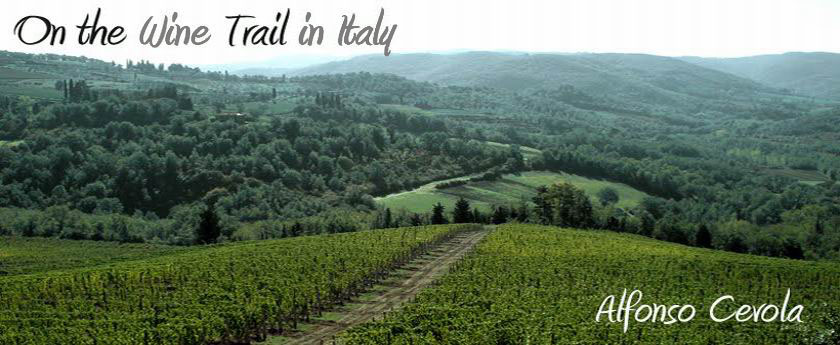It was a pivotal moment in Italian wine necromancy, initiated by our little cadre of immortals, filched (or interpolated?) by the high priests of the Catholic Church in Rome. This, not the wine in Campania, not the Greeks in Calabria and Sicily, not the Etruscans. No, the New Testament era of Italian wine was transmitted by the monks and priests, alchemists, all of them. And guided by our immortal, unseen hands. And that is how we got to where we are today. Winemaking, traveling through time, as a dark art. Or at the very least, invisible.
Nowadays, winemakers have all kinds of techno-sorcery at their disposal. From spinning cones to Mega Purple. From something as simple as those little green wires they hang in the vineyards laden with pheromones to cause sexual confusion among unwanted pests so that their procreative abilities are stifled. And what is darker than loading up a cow horn with manure, preferably from a lactating cow? That ain’t conjuring? Yeah…OK.
Bring it on, some of us have all the time in the world. And then some. The simple act of crushed grapes, consisting mainly of water, which over time turns into this fermented beverage called wine, call it a miracle or call if magic. What’s not to love? most Italians do. So do most humans (mortal and otherwise) who have grown up in a culture conducive to the enjoyment of such a forbidden pleasure.
Fast forward to present time. Today’s “instant” sorcerers think that all they need is an iPhone and an Instagram account in a vain effort to gin up immortality. Ha! To those of us immortals, who have “done the time” with nary as much as a divining rod, there’s so much more to necromancy than meets the eye. The business of it is the work of conjuring up living wine from dead grapes and giving life to something that in the future will give back to the living ones.
The living ones. Those who are alive at the time. The naked apes. If that is you, know that wasn’t always you, and won’t always be you. Unless you are one of us who have escaped the mortal bonds. Not that living forever is a walk in the park.
Although, when we do take that walk in the park, it is as an invisible being, cloaking device activated. For we wouldn’t like to scare the little children out and about in their search for free candy.
Free candy. That was what the wine at Cana tasted like. Sweet, syrupy, like honey. The crowd loved it. The couple who got married had ten children. One became a winemaker. His descendants settled in Persia, and then in Tuscany they established a business that has been operating for over 600 years. Our little group of immortals know the place backwards and forwards, as we do most places like this, in Italy, France, Germany and Spain. We have all the time in the world.
So it is funny to see the mortals running around like they do too. But when you’re 28, or 44, what else do you know? Put a thousand years in, and your perspective widens a bit.
And so, it has been, for those of us who preside over the art of wine, to steer ever so carefully, the path of wine and winemaking. And for those of us who have been eternally entrusted to Italy and wine, these little changes, which might seem huge to the mortal, are really small, incremental adjustments. Developments in yeast strains? Thanks to that early Cana wine dynasty, on their way to Italy, a generation or two in and around Lake Urmia was the happy “accident” for that. Oak? Telekinesis is much easier with wood than concrete and less fragile than those amphorae stuck in the sand. Trellising? One of us who hasn’t slept for going on 800 years now, the overachiever of the group, became fanatical about the subject and devoted 200 years (all waking hours!) to the study. Cordone speronato, ha! This deathless one hasn’t even begun to develop what he unearthed about the subject. But he thinks in the next 300 years or so he will be able to get the work out into the fields. Vine spacing practices are in for a major revolution in 2200 AD.
The idea that Nebbiolo and Sangiovese are the end, the destination, for Italian wine expression? in 100 years people will laugh at those of you alive who are reading this. You’ll be dead, so the joke will fall to the bardo, but 200 years ago, people in Tuscany thought Gamay was all the rage. Until one of ours wiggled his way into a castle in Gaiole and changed all that. Time is a river, everything changes.
Time is a treat. And time is a trick. What you naked apes don’t know is that sometimes we trick you. And sometimes we send you a treat. Pinot Grigio? Moscato? Prosecco? Chianti? Trick or treat?
Go ahead, run around in your costumes, looking for your free candy. Post your silly little stories about who has better taste, who has trendier pet nat for Sicily. We’ll be here, when you are looking for your cane, and a clean diaper. Silly little mortals.
1,700 years? Hell, we’re just getting started.
written and photographed (in Friuli) by Alfonso Cevola limited rights reserved On the Wine Trail in Italy
wine blog + Italian wine blog + Italy W






